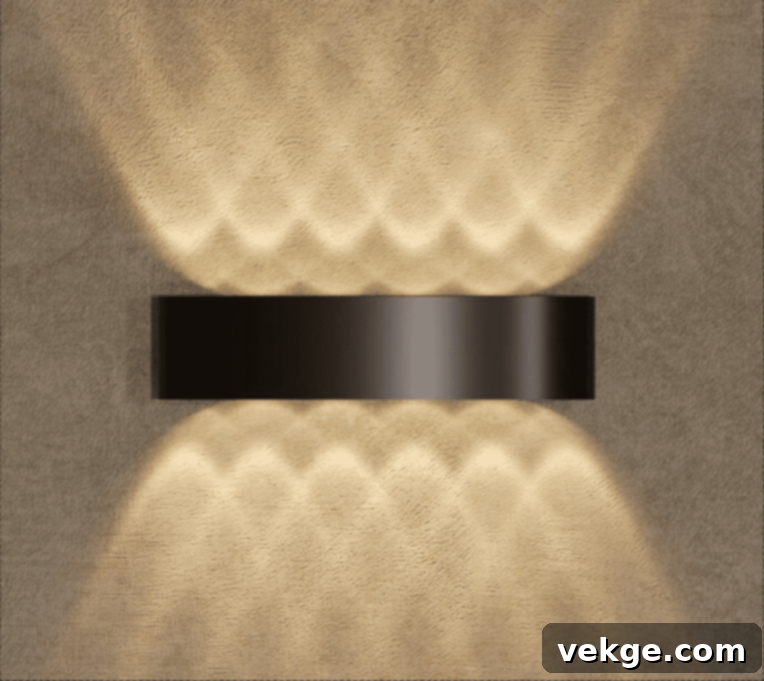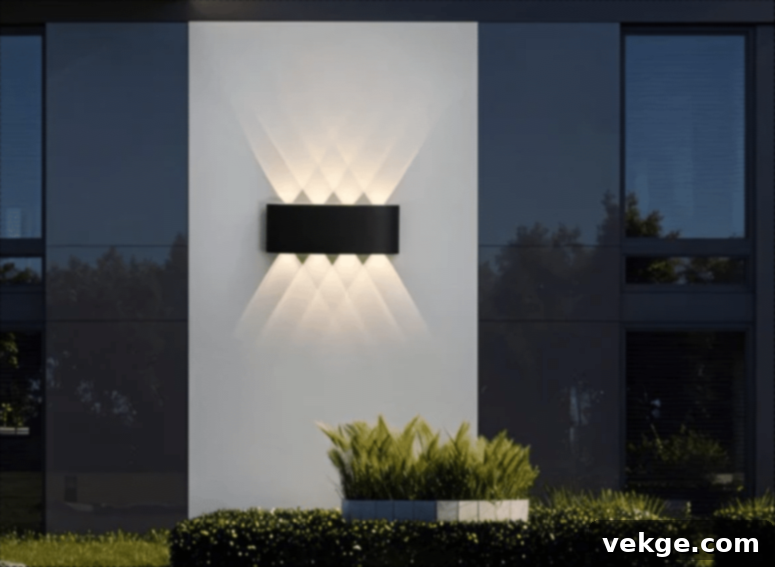Illuminate Your Space: The Ultimate Guide to Choosing Stylish & Functional Wall Lamps
Wall lamps are far more than just sources of light; they are integral elements that define the mood, enhance the aesthetics, and optimize the functionality of any room. While their primary role is to light up a space and serve as a guiding beacon in the dark, their impact extends much further. Functionality remains the cornerstone of selecting the right wall lamp, ensuring it meets your practical lighting needs, whether for reading, task illumination, or general protection.
Wall lamps are designed with a myriad of uses in mind. From providing essential illumination in a hallway to creating a cozy ambiance in a living room, their practical applications are diverse. However, what truly elevates a good wall lamp to a great one is its style. The design of the wall lamp you choose is not just an afterthought; it’s a critical factor that influences the overall decor and personality of your home.
While functionality is undeniably paramount, the aesthetic appeal of a wall lamp should never be underestimated. Incorporating style into your selection criteria ensures that your lighting fixtures contribute positively to your interior design scheme. A well-chosen wall lamp can inject character into your home, serving as a decorative element even when unlit. It’s an investment that enhances both the practical and visual aspects of your living environment.
Therefore, the ideal wall lamp seamlessly blends functionality with its design. The perfect wall light for your home or any specific room should be a harmonious fusion of purpose and aesthetics. By considering both these key aspects, you unlock the potential to transform your space into a beautifully lit and visually engaging sanctuary.
How to Choose the Best Wall Lamp for Your Home
Selecting the perfect wall lamp requires thoughtful consideration of several factors. Before diving into styles and designs, it’s essential to understand your specific needs and how wall lighting can best serve your home. Here are the crucial questions to ask yourself:

Why Do You Need Wall Lights? Understanding Their Purpose
When the term “wall lights” comes to mind, many people immediately picture decorative sconces primarily used for accent lighting, often without significant practical illumination. While wall lights excel in their decorative capacity, their utility extends far beyond mere accents. They are versatile lighting solutions employed for various purposes, including:
- Task Lighting: Ideal for specific activities like reading in bed (swing-arm lamps), applying makeup (vanity lights), or preparing food in the kitchen. They provide focused illumination precisely where it’s needed.
- Ambient Lighting: Used to create a general glow and set the mood in a room. When used instead of or in conjunction with overhead lights, wall lights can produce a softer, more inviting ambient effect, minimizing harsh shadows and glare.
- Accent Lighting: Perfect for highlighting architectural features, artwork, or decorative elements. Picture lights, for example, are specifically designed to illuminate paintings and photographs, drawing attention to them.
- Security and Guidance: In hallways, stairwells, or outdoor areas, wall lights provide essential guidance and enhance safety by illuminating pathways and potential obstacles.
Wall lighting is an indispensable component of a properly layered lighting design. A layered approach combines ambient, task, and accent lighting to create a flexible, functional, and aesthetically pleasing environment tailored to different activities and moods throughout the day.
Where Should You Integrate Wall Lighting? Placement for Optimal Effect
Wall lights are incredibly adaptable and can be integrated into a multitude of spaces, both indoors and outdoors. Their strategic placement can significantly impact a room’s functionality and atmosphere:
- Hallways and Entryways: Wall sconces provide a warm welcome and guide visitors through transitional spaces. They eliminate the need for overhead fixtures in narrow corridors, making the space feel more open.
- Living Rooms: Use wall lights to complement ceiling lights, providing supplemental illumination and creating a more intimate ambiance. They can highlight artwork or define seating areas.
- Bedrooms: Swing-arm wall lamps serve as excellent bedside reading lights, freeing up nightstand space. Dimmable wall lights can create a relaxing atmosphere.
- Bathrooms: Vanity lamps are an essential part of bathroom lighting layering, providing even, flattering light for grooming tasks. Spiral LED lighting or modern sconces can add a touch of elegance.
- Dining Areas: Wall lights can create a cozy, intimate setting for meals, especially when used in conjunction with a dimmer switch.
- Outdoor Spaces: Exterior wall lights enhance curb appeal, provide security around entrances, patios, and decks, and illuminate pathways for safety.
When used in conjunction with ceiling lights, wall-mounted fixtures provide crucial supplemental lighting. Conversely, opting for wall lights instead of relying solely on overhead fixtures often results in a warmer, more inviting ambient effect and a significant reduction in harsh glare, contributing to a more comfortable living environment.
How Many Wall Lights Do You Need? Spacing and Distribution
The correct placement and number of your wall lights are crucial for maximizing their effectiveness and achieving the desired lighting effect. While factors like ceiling height and fixture size play a role, a general guideline for placement is at eye level, typically between 5.5 to 6 feet from the floor. This height ensures that the light spreads effectively without shining directly into your eyes, especially if the bulb is exposed.
For hallways, a common area for wall lights, it’s easy to overdo it. Too many lights in a long, dark hallway can make it feel like an airport runway rather than a welcoming passage. A good starting point is one fixture every 8 to 10 feet. However, this can vary based on your space’s specific dimensions, the lumen output of the fixtures, and their size. You might need slightly more or less spacing depending on these variables.
A more aesthetically pleasing configuration for hallways involves staggering the lights, placing them in an alternating pattern on opposite walls. This creates a softer, more balanced illumination and adds visual interest. For decorative purposes, you might use fewer fixtures, strategically placed to highlight specific areas or features.
Another important consideration is how far a fixture projects from the wall. Low-profile fixtures are ideal for narrow hallways, stairwells, and high-traffic rooms where space is at a premium and you want to avoid obstruction. ADA-compliant fixtures, for example, typically project no more than 4 inches from the wall, making them perfect for public spaces and areas with accessibility concerns. Advances in LED technology allow for even thinner designs, ensuring a perfect fit for almost any space, no matter how constrained.
What are the Different Styles of Wall Lights Available on the Market?
The market for wall lights is incredibly diverse, offering an extensive range of styles, materials, and designs to suit every taste and interior theme. Wall lights are not only popular for residential use but are also widely utilized in workshops, factories, garages, and various other commercial and industrial buildings. While some are designed with a simple, robust industrial aesthetic for purely practical use, many are crafted to combine functionality with decorative flair, enhancing homes and indoor environments.
You can find wall lamps designed to mimic the charm of antique, industrial, and rustic wall sconces, often featuring distressed metals, exposed bulbs, or barn-style shades. These styles add character and a sense of history to a space. On the other hand, for those who prefer a more contemporary look, there are abundant modern and Nordic designs characterized by clean lines, minimalist forms, and innovative materials. These often incorporate sleek metals like chrome or brushed brass, frosted glass, or geometric shapes.
Beyond these broad categories, the spectrum of styles includes:
- Contemporary: Blending modern elements with timeless appeal, often featuring unique shapes and materials.
- Traditional: Classic designs with ornate details, often in bronze, brass, or wrought iron, suitable for formal settings.
- Farmhouse: A rustic yet refined look, often incorporating wood, distressed metal, and simple, cozy aesthetics.
- Coastal: Inspired by the sea, using elements like rope, weathered wood, and nautical motifs.
- Mid-Century Modern: Characterized by organic shapes, clean lines, and a mix of materials like wood and metal from the mid-20th century.
Wall lamps are typically attached to a mounting plate, often featuring curved metal rods, plates, or other decorative elements, and are connected to the building’s existing electrical wiring for a permanent, integrated lighting solution. These types of wall lights are installed for a multitude of reasons, ranging from practical convenience and targeted illumination to enhancing safety and purely aesthetic decoration.
Beyond the Basic: Exploring Types and Benefits of Wall Lighting
Understanding the different types of wall lights can further refine your selection process, ensuring you choose the most appropriate fixture for your specific needs:
- Wall Sconces: The most common type, projecting light upwards, downwards, or both. They are excellent for ambient and accent lighting.
- Picture Lights: Specifically designed to illuminate artwork, these lights provide focused, even illumination without glare.
- Swing-Arm Lamps: Highly functional, these lamps have an adjustable arm, making them perfect for task lighting beside a bed or sofa.
- Uplights/Downlights: Some wall lights are designed to cast light primarily upwards (uplights), creating a soft, indirect glow that highlights the ceiling, or downwards (downlights), providing focused illumination on the wall or floor. Many models offer both capabilities.
- Washlights: Designed to “wash” a wall with light, creating a dramatic effect and making a space feel larger.
- Vanity Lights: Primarily used in bathrooms, these fixtures provide bright, even illumination around a mirror.
The Benefits of Integrating Wall Lighting into Your Home
Beyond their aesthetic appeal and functional diversity, wall lights offer several practical advantages:
- Space Saving: Unlike floor or table lamps, wall-mounted fixtures don’t occupy valuable floor or surface space, making them ideal for smaller rooms or cluttered areas.
- Energy Efficiency: Modern wall lamps, especially those utilizing LED technology, are incredibly energy-efficient, offering significant savings on electricity bills and a longer lifespan.
- Ambiance Creation: Wall lights excel at setting a mood. Dimmable options allow you to adjust the light intensity, transforming a bright room into a cozy haven with a flick of a switch.
- Enhanced Safety: By illuminating pathways and dark corners, wall lights reduce the risk of trips and falls, particularly in hallways, stairwells, and outdoor areas.
- Architectural Accentuation: They can highlight unique architectural features, textured walls, or decorative elements, adding depth and interest to your interior design.
Conclusion: The Perfect Blend of Form and Function
In conclusion, choosing the right wall lamp is about striking a perfect balance between its practical utility and its decorative impact. While some wall lights are versatile enough to act as both uplights and downlights, offering the best of both worlds in terms of light distribution, many models also come with convenient built-in switches for independent access and control. Furthermore, innovative pin-up kits allow you to insert certain fixtures into any available socket, completely eliminating the need for complex hardwiring and offering unparalleled flexibility.
While few wall lights are bright enough to provide the sole source of total ambient light for an entire space, their true power lies in their ability to complement other lighting layers. By strategically scattering them throughout a room or utilizing them as a focal point to highlight specific areas or artworks, wall lamps can create a truly beautiful and dramatic lighting solution. They are essential tools for crafting a layered lighting scheme that is as functional as it is aesthetically pleasing, transforming ordinary rooms into extraordinary living experiences. Investing in thoughtful wall lighting means investing in the character, comfort, and functionality of your home.
